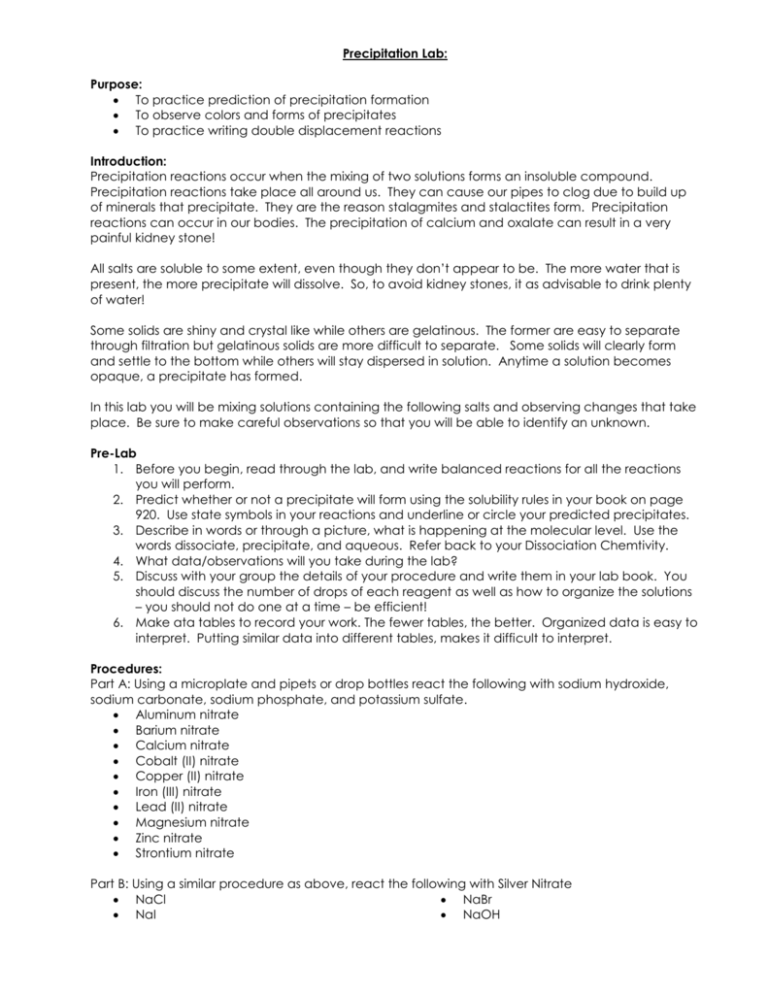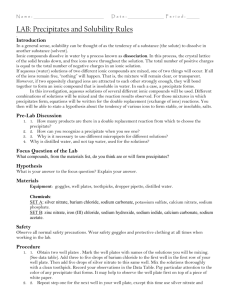Precipitation Lab:
advertisement

Precipitation Lab: Purpose: To practice prediction of precipitation formation To observe colors and forms of precipitates To practice writing double displacement reactions Introduction: Precipitation reactions occur when the mixing of two solutions forms an insoluble compound. Precipitation reactions take place all around us. They can cause our pipes to clog due to build up of minerals that precipitate. They are the reason stalagmites and stalactites form. Precipitation reactions can occur in our bodies. The precipitation of calcium and oxalate can result in a very painful kidney stone! All salts are soluble to some extent, even though they don’t appear to be. The more water that is present, the more precipitate will dissolve. So, to avoid kidney stones, it as advisable to drink plenty of water! Some solids are shiny and crystal like while others are gelatinous. The former are easy to separate through filtration but gelatinous solids are more difficult to separate. Some solids will clearly form and settle to the bottom while others will stay dispersed in solution. Anytime a solution becomes opaque, a precipitate has formed. In this lab you will be mixing solutions containing the following salts and observing changes that take place. Be sure to make careful observations so that you will be able to identify an unknown. Pre-Lab 1. Before you begin, read through the lab, and write balanced reactions for all the reactions you will perform. 2. Predict whether or not a precipitate will form using the solubility rules in your book on page 920. Use state symbols in your reactions and underline or circle your predicted precipitates. 3. Describe in words or through a picture, what is happening at the molecular level. Use the words dissociate, precipitate, and aqueous. Refer back to your Dissociation Chemtivity. 4. What data/observations will you take during the lab? 5. Discuss with your group the details of your procedure and write them in your lab book. You should discuss the number of drops of each reagent as well as how to organize the solutions – you should not do one at a time – be efficient! 6. Make ata tables to record your work. The fewer tables, the better. Organized data is easy to interpret. Putting similar data into different tables, makes it difficult to interpret. Procedures: Part A: Using a microplate and pipets or drop bottles react the following with sodium hydroxide, sodium carbonate, sodium phosphate, and potassium sulfate. Aluminum nitrate Barium nitrate Calcium nitrate Cobalt (II) nitrate Copper (II) nitrate Iron (III) nitrate Lead (II) nitrate Magnesium nitrate Zinc nitrate Strontium nitrate Part B: Using a similar procedure as above, react the following with Silver Nitrate NaCl NaBr NaI NaOH Analysis: 1. A net ionic equation is one that includes only those dissolved ions that undergo a reaction. For example, in writing a net ionic equation for the reaction of HCl with NaOH, the following steps are taken. a. b. c. d. Write the balanced equation showing the complete formulas for the reactants and products. HCl(aq) + NaOH(aq) NaCl(aq) + H2O(l ) Rewrite the equation with all ions separated or dissociated. Formulas for solid precipitates, gases, or liquids should be written as undissociated compounds. H+(aq) + Cl-(aq) + Na+(aq) + OH-(aq) Na+(aq) + Cl- (aq) + H2O(l ) Cross out any ions that appear in the same form on both sides of the equation (in this case, Na +and Cl-). H+(aq) + Cl-(aq) + Na+(aq) + OH-(aq) Na+(aq) + Cl- (aq) + H2O(l ) Rewrite the equation omitting any ions that were crossed out. H+(aq) + OH-(aq) H2O(l ) Write the net ionic reactions for the silver reactions you performed in part B. 2. Would the reactions have been different if potassium hydroxide (KOH) had been used instead of sodium hydroxide? Explain your answer. Hint: Write the net ionic equation using KOH(aq) instead of NaOH(aq). 3. All the reactants in these reactions are solutions of ionic compounds. Do you think the characteristic colors of the reactants and the products are caused by the cations or the anions in the compounds? Explain your reasoning. 4. How many drops of NaOH are needed to react completely with 5 drops of each of the metal nitrate solutions, if all the drops are the same size? (Hint: use the balanced chemical equations and assume that the concentrations of all the reactants are the same.) 5. Can you think of a way to use the products of these reactions to make an estimate of the concentration of unknown concentrations (you know what is in the solution but you don’t know how much)? Concentration can be measure in many different ways, however, in chemistry we measure it in moles per liter. Write a procedure for making this determination using information in this lab (do not use colorimetry). 6. The 0.1 M NaOH solution has a pH of 13.0. The mathematical relationship of pH to OHconcentration in moles per liter is given by the following equation. pH =14.00 + log10[OH-] Describe how you could use a pH meter to estimate the concentration of the Na+ ions in an unknown solution. Teacher Notes Nitrate Al Ba CaCl Co Cu Fe Pb Mg Zn Sr Molar MassVolume Molarity Moles Mass 375 100 0.5 0.05 18.75 261.34 100 0.5 0.05 13.07 147.02 100 0.5 0.05 7.35 182.94 100 0.5 0.05 9.15 187.56 100 0.5 0.05 9.38 241.86 100 0.5 0.05 12.09 331.2 100 0.5 0.05 16.56 256.41 100 0.5 0.05 12.82 297 100 0.5 0.05 14.85 211.63 100 0.5 0.05 10.58 NaI NaCl NaBr 149.89 58.44 102.89 100 100 100 0.5 0.5 0.5 0.05 0.05 0.05 7.49 2.92 5.14 NaOH NaCO3 Na3PO4 K2SO4 39.997 105.99 163.94 174.26 200 200 200 200 0.5 0.5 0.5 0.5 0.1 0.1 0.1 0.1 4.00 10.60 16.39 17.43







